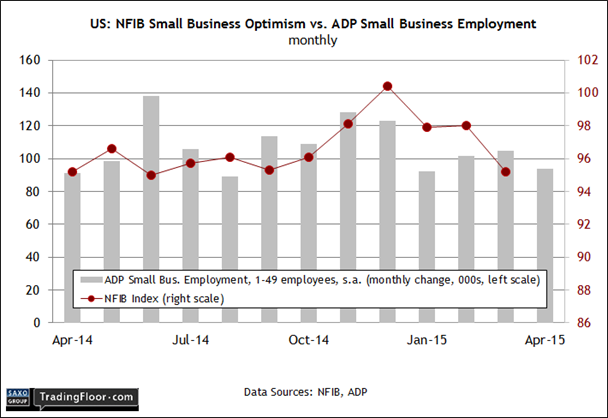The pace of economic releases picks up a bit on Tuesday, including the monthly update on UK industrial production. Later, new data for two widely followed US indicators – NFIB’s Small Business Optimism Index and the government’s job openings figures – will be closely analysed for clues on the outlook for the economic trend in the second quarter.
UK: Industrial Production (08:30 GMT) The Bank of England yesterday, as expected, left its policy rate unchanged at a record low of 0.50%, in part because the inflation rate is currently zero – far below the BoE's 2% target rate. But if “low-flation” is keeping rate hikes in check, it’s not obvious that the weak pricing pressure is weighing on growth.
UK GDP expanded at a solid 0.6% pace in this year’s first quarter, according to the April estimate from the National Institute of Economic and Social Research (NIESR). The rise matches the NIESR’s rolling quarterly estimates since last November. (NIESR publishes its May estimate today at 14:00 GMT).
The rear-view mirror suggests that Britain’s economy continues to hum along at a healthy rate. Business survey data, however, suggests that growth is at risk of decelerating in the second quarter. The Markit/CIPS UK Manufacturing Purchasing Managers' Index (PMI) dipped to a seven-month low in April. The latest PMI reading of just 51.9 – down sharply from 54.0 in the previous month – is uncomfortably close to the neutral 50.0 mark that separates growth from contraction.
“Rates of expansion in production and order books both slowed sharply in April, meaning manufacturing is again unlikely to provide much of a boost to broader economic growth,” a Markit economist noted earlier this month.
Britain has recently been hailed as one of the developed world’s stronger economies in terms of overall growth. The forward momentum remains largely intact, although the soft PMI data raises questions about today’s report on industrial activity for March – the first economic release since last week’s election.
Headline industrial output was virtually flat on a year-over-year basis through February, rising a thin 0.1% vs. the year-earlier level. The manufacturing component is modestly stronger, advancing 1.0% for the past 12 months, although that’s still well below the pace in recent history. Is this a sign of support for the PMI's forecast of a slowdown in UK growth?
Today’s report will be widely read in search of a new clue for deciding what comes next. Economists are expecting another soft round of annual comparisons in the hard data for March. If so, the post-election period for official macro releases will be off to a shaky start. 
US: NFIB Small Business Optimism Index (13:00 GMT) Last week’s solid gain in nonfarm payrolls in April suggests that the disappointing economic performance in the first quarter may rebound in Q2. But if there's a revival underway, it's not yet obvious in the Atlanta Fed’s still-weak GDP nowcast for this quarter. The bank’s current estimate: an expected gain of just 0.8%, which isn’t much higher than the nearly stagnant Q1 increase of 0.2%.
It’s still early, of course, and so deeper confidence about Q2, for good or ill, will take time. The next major releases for April: Wednesday’s retail sales report and Friday’s update on industrial production.
Meanwhile, yesterday’s releases that offer deeper perspective on the labour market present conflicting views. On the one hand, the Conference Board’s Employment Trend Index (ETI) ticked up to an eight-year high in April, boosted by gains in seven of its eight components. It's a slightly different story for the Federal Reserve’s Labor Market Conditions Index (LMCI), another measure that aggregates a variety of data. LMCI weakened further in April, sinking to its lowest point in nearly three years.
The US macro outlook, in short, is still in flux, which helps explain the recent weakness in the mood in the small-business sector, as calculated by the National Federation of Independent Business (NFIB). In the March release, the Small Business Optimism Index slipped to a nine-month low of 95.2.
Economists expect that some of that loss will be recovered in today’s April report. Econoday.com’s consensus forecast calls for a slight rise to 96.0. That’s a mild improvement, but even a small gain will strengthen the view, if only slightly, that the second quarter will compare favourably to Q1.
US: Job Openings and Labor Turnover Survey (14:00 GMT) Today’s monthly data on the availability of new jobs, offers yet another perspective on the labour market. Although these numbers lag most other indicators by one month (today’s release is for March), this report is highly prized as a forward-looking measure of the job market’s growth momentum (or the lack thereof).
Judging by recent standards, the trend looks quite healthy. Job openings increased to 5.13 million in February – the highest since 2001. Econoday.com’s consensus forecast tells us that openings will inch higher still in today’s March report with a slight rise to nearly 5.16 million.
The strength in the number of openings in recent months, contrasts with some employment indicators. But if we see today’s update hold above the 5 million mark, this widely followed indicator will renew its bullish forecast for the labour market and in the process strengthen the case for anticipating a rebound of some degree in economic growth for the second quarter.
Disclosure: Originally published at Saxo Bank TradingFloor.com
